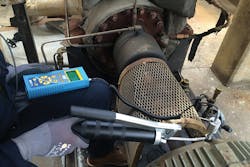Benefits of ultrasound for condition monitoring
Solving asset reliability issues becomes stymied when leadership is ambivalent about the benefits of adopting multiple technologies for condition monitoring (CM). When they do adopt them, they quickly learn technologies alone are not enough without the manpower to deploy them. One colleague stoically relayed his frustration when he said, "There are never enough of us (manpower), but there are more of them (problems) every day."
Monitoring asset condition cannot be carried out effectively with only one CM technology, yet many maintenance departments rely predominantly on data from "just vibration" or "just oil analysis," for example. More than one failure mode threatens asset health, and not every symptom is detectable by the same method. Some organizations have a strong vibration program but not anything more. Others may see clearly with infrared thermal imaging but lack a good oil analysis solution. A broader focus nets greater results.
Implementing several CM technologies is practical but often restricted by available manpower, budget and lack of conviction from all departments. If this is your plant’s reality, perhaps start with the most versatile technology — the one that detects the most defects — with the shortest learning curve. Choose ultrasound first and build a program on that foundation.
Benefits of ultrasound
Ultrasound testing presents a solution for shrinking manpower and a growing number of problems. First, it is versatile. Many of the defects haunting maintenance personnel are detectable with ultrasound. Second, it is not prohibitively expensive. Quality equipment requires an investment on par with, or even lower than, conventional CM technologies. Third, it is deployable. Implementing ultrasound into a reliability department is painless, fast and scalable.
Ultrasound, a validated CM technology, is versatile and inexpensive with a low learning curve — a formula for a fast return on investment. The investment improves overall asset reliability and operational excellence.
Reliability & operational excellence
Improving reliability and operational excellence are absolute priorities within every organization. These initiatives open more questions, create a lot of tasks and throw up countless obstacles. When every stakeholder has ownership, each becomes a leader, and questions, tasks and obstacles are tossed aside. Still, many reliability projects fail or perform below expectations. Maybe they fail because they were called "projects," and the very use of that word implies change. Many still resist change, digging in their heels until the deadlines pass, hoping things happen without their involvement.
Reliability improvement and operational excellence must start with a revolution and continue as an evolution. No time frame exists for continuous improvement, but if it did, matters would improve until the deadline and then revert to old ways. It would just be called improvement, but it would not be continuous. Team members must accept they are all part of the never-ending revolution.
Communication also plays a vital role. Less than 10 percent of employees clearly understand their company’s strategy. The purpose for the revolution must match the organization’s operational mission and be communicated from the executive suite to the plant floor. Poor communication should trigger alarms because strategies, ideas and tasks are blurred as they travel from the top of the pyramid to the base. By the time an idea travels from the top to the bottom, it rarely resembles its original self because communication blurring is often compounded by the existence of mini pyramids within the big pyramid.
Culture change has been talked about a lot lately. Programs that encourage change can cause more blurriness, but real change happens when strategies are explained and implemented. Looking through another lens reveals that not every element of change is necessary.
Employees, especially those who are parents, understand these concepts already. Raising children without performance indicators (KPIs), failure mode and effect analysis (FMEA) and root cause analysis (RCA) is impossible. Parents might not use these exact terms in the context of parenting, but they monitor the condition of their children daily and compare results to peer groups. How do their child’s health, first tooth, height and weight, and learning to read and solve math problems compare to others?
In many cases, this inherited reliability culture stays at home, and a trained body goes into the plant. At home, a sign in the bathroom to remind employees to wash their hands is unnecessary. Why is one needed at work? If so much effort is required to remind employees about basic personal hygiene, what chance do we have to affect real culture change and revolution? Perhaps the answer lies in searching for the exact point at which common sense was rejected.
Sometimes the complexity of knowledge is too great. The ideas resemble large blocks that need to be sliced into smaller, more digestible projects that are easy to swallow yet have the potential for huge impact. Often inspectors need only to adopt a small slice of knowledge for the technology to have a positive impact. Micro projects all contribute to macro results.
Ultrasound technologies implemented in concert with an organization’s reliability mission is one solution. Ultrasound encourages a high level of involvement across the entire operation and has the capacity to lead culture change. The solution is versatile and appeals to departments at all levels. Its positive impact resonates through energy efficiency, asset longevity, product quality and the bottom line.
Ultrasound solves complex machine issues in a simple way. It detects friction, impacting and turbulence — three phenomena commonly associated with asset defects. Most FMEA projects show ultrasound is a strong candidate for condition monitoring. For some assets, it is the first line of defense, while for others it is the only line of defense. Does that mean ultrasound is the best asset condition monitoring technology? No, it all boils down to matching the technology to the defect. It just happens that ultrasound matches a broad spectrum of potential failures.
Ultrasound can detect and trend pump cavitation problems.
Where is ultrasound useful?
The eight pillars of ultrasound are:
- Machine condition monitoring
- Acoustic lubrication of bearings
- Leak detection
- Steam trap assessment
- Electrical inspections
- Valves
- Hydraulics
- Tightness testing
Defects related to these eight pillars all produce friction, impacting or turbulence. Some defects such as compressed air leaks are binary. Others such as a bearing are identified by trending data over time because trending makes the exact moment of failure predictable. Some defects such as a broken gear inside a complex gearbox require analysis.
The eight pillars represent tremendous opportunities. These inspections can be carried out by various levels of skilled personnel. Each application exists as a micro project inside a macro mission. Every tiny win contributes to the grand prize, which for some is the difference between staying in business or closing the doors.
One thermal power generation plant had the focus to improve the effectiveness of CM on rotating assets. Bringing two complementary technologies together for one task allowed for inclusion of more assets with the same manpower. Remember the "less of us" and "more of them" problem? Less skilled inspectors collecting ultrasound data left time for higher skilled analysts to focus on only the bad actors. Ultrasound detects early stage defects, so prescribed, corrective maintenance activities are simple. Averted catastrophic failures mean less downtime, less spare parts and repairs completed by in-house maintenance instead of out-sourced specialists.
In time, more assets and inspectors were added. Knowledge was shared, and people became engaged and empowered. Additional technology and training were budgeted to increase capabilities. Where did the additional budget come from? The management provided it because success created belief at all levels. The message was communicated from the base of the pyramid back to the top, and this time it arrived intact. Culture change happened, and no one saw it coming.
Identifying new areas for ultrasound deployment became the logical next step. Rotating assets were only part of the focus. All eight pillars were fully adopted, and the little slices of micro projects came together. A team dedicated to managing compressed air and exotic gas leaks was formed.
That same team assessed steam system function. Lubrication of motor bearings was identified as critical, and on-condition lubrication replaced calendar-based lubrication full stop. Immediately, the "grease monkey" became a lubrication technician, and consumption of grease decreased while grease-related motor failures disappeared, and grease storage improved. Rounding out the adoption of ultrasound was a project focused on identifying and replacing faulty steam traps.
The versatility of ultrasound lends itself well to reliability and operational excellence but not on its own. More technology is always better than not enough. Bringing about change is a revolution followed by an evolution that is ongoing until someone decides it is no longer a good idea. Ultrasound provides a way to affect that change by breaking complex blocks of knowledge into small slices that are easily digested by teams of engaged and empowered personnel. Improving the reliability of a facility is a huge project, but the eight pillars of ultrasound create micro projects that contribute to the cumulative greater good in a way that empowers all team members with leadership.
Allan Rienstra is the director of business development for SDT International, where he has provided ultrasound solutions to maintenance professionals since 1991 and supports a growing number of world-class ultrasound implementations. As co-author of the book Hear More: A Guide to Using Ultrasound for Leak Detection and Condition Monitoring, Rienstra is recognized around the world as a subject matter expert in the field. He lives in Cobourg, Canada, and can be reached at [email protected].

